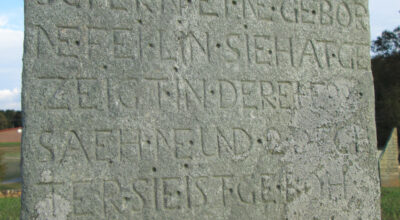No more Horah (a railroad crossing remembered)
Published 12:00 am Monday, August 11, 2014
Hearing an approaching train at the Danville Science Center the other day, I looked toward the tracks, nothing unusual since the Science Center’s natural history collection is housed in the old Danville train station.
The sight promised by that approaching rumble never disappoints, even when not boxcars, but only truck containers being efficiently hauled en masse. (Rail cars are beneath, but they are “flat.”)
Looking solely at transported containers resembles setting a chair along I-85 and watching the passing trucks (but no “piggybacks” there).
Trucks don’t have the same romantic aura as trains. Little boys don’t beg their fathers to take them down to the interstate to watch the 18-wheelers roll by (this coming from someone whose uncle once drove a truck for Virginia-Carolina Trucking Co.).
A great variety of boxcars made up that recent train, specific cars for specific things: wood, gravel, automobiles, frozen food, even liquids such as “molten sulphur.” If one of those sulphur tank cars derails and breaks, that famous Shakespearean odor from Denmark will spread throughout the local scene. Being sulphur (brimstone), it would “smell like hell” (literally, not just an exclamatory phrase).
That day, I saw a motley assortment of boxcars bearing the names of rail systems from across the country, some still with us, some combined with others (Norfolk-Southern), and some, no more.
Several Norfolk-Southern cars looked brand new, the bolts and lines of their construction clearly defined. They had a certain “shininess” in which one could probably see his reflected face if close enough (but not too close).
The particulars of construction of many, yet-rail-riding, old Southern Railway boxcars were blurred by fuzzy “rust crystals.”
A great “oxidized” old boxcar passed. It was coupled between two much-newer ones, but even in its “ruined” condition, it upstaged them both.
I was able to make out only a few letters through the rust, but enough to tell that it was one of those innovative (for the time) Southern Railway “Super Cushion Service” boxcars from the 1960s. At that moment, I thought back to Southern’s innovative (for any time) and controversial president D.W. Brosnan.
I confess that in my deciphering of those rust-laden words, I had a mental “cheat sheet,” having seen them in their visual prime at Salisbury’s Horah Street railroad crossing.
In the very late 1950s to very early ’60s, my brother Joe would drive me down to the Salisbury Station and we would watch the passenger trains, with their silver, “ribbed” cars.
In the late afternoons, I rode with my father to pick up my mother when she got off work at Salisbury’s W.T. Grants.
On that mission, my father took the Old Concord Road toward Salisbury, passed through Dixonville (in its formerly sad state), then turned left on Horah Street to head downtown.
Since we sometimes waited for passing freights, part of my first knowledge of rail cars was gained at the old Horah Street crossing (a certain number of “life’s minutes” spent waiting at that spot). I gained a knowledge of the painted (professional, not graffiti) names and slogans of a variety of rail systems from across the USA and Canada.
The Chessie System’s “pillowed” cat was a favorite, but the bywords of Southern Railway were dearer, since my father was a clerk at Spencer. Primarily, they read: “Southern,” “Southern Serves the South” and “Southern Gives a Green Light to Innovation.”
Many of those old slogans are now partially masked by rust, but moved then in perfect clarity, like a CNN “news crawl” down the rails.
Present viewing of those rust-masked letters makes it seem like a strange variation on “Wheel of Fortune” or “Concentration” in piecing those old “mission statements” together again; but railroad people already know what they say anyway.
Some years ago, I saw in the online Salisbury Post where Norfolk-Southern was closing the Horah Street crossing and would be placing permanent barriers and flowers at its opposite ends.
A few weeks ago, I was in Salisbury. When crossing the tracks down from Horah, I saw in the distance that Norfolk-Southern was true to its word, and had closed the old crossing.
I couldn’t make out whether or not the additional promise of flowers had been fulfilled. If it has, newcomers to Salisbury will see those buds and blooms as purely decorative; but to those of us not so new, “in memoriam” may be read by their presence there.


